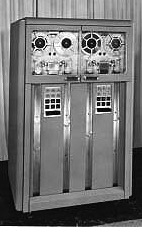History (1950s): Magnetic Tape Storage
Following invention called vacuum column
This is a Press Release edited by StorageNewsletter.com on June 19, 2018 at 2:21 pmThis article came from IBM Corp.
Magnetic Tape Storage
IBM 726

An unglamorous invention called the vacuum column wound up being the key in the 1950s to a whole new generation of storage technology based on magnetic tape.
The technology helped boost the speed of data processing and solve the problem of the tidal waves of punched cards flooding corporate and government offices.
By the early 1950s, IBM, Remington Rand and other companies were working on the first commercial electronic computers, using vacuum tubes instead of the old mechanical switches found on tabulating machines. The processors in these pioneering machines ran so fast, computer memory and storage could not keep up. The electronic machines were reading more than 150 punched cards per minute, taxing the upper limits of paper card computing. Electronics could compute much faster than information could possibly be read from punched cards.
The race for faster, larger memory and storage became the headline story. The company with the best media stood the best chance of winning the first wave of the electronic computing era.
Magnetic recording on wire was introduced to the world by Danish engineer Valdemar Poulsen at the World’s Fair in Paris in 1900.
German engineers in the 1930s perfected steel magnetic tape, and IBM engineers were experimenting with magnetic coated plastic tape in the 1940s with the idea of using it as a medium for storage and retrieval. This is when they encountered a problem. They had to be able to start and stop the thin tape at high speeds without breaking it. The competing Univac employed a heavy metallic tape to avoid this problem, but the heavy tape had obvious drawbacks.
Mechanical engineer James A. Weidenhammer and a team of six engineers working out of IBM’s facility in Poughkeepsie, New York, were assigned to solve the tape problem and develop a high-speed drive. “We had no clear idea of which approach to take,” he said. “Very fast starts and stops were desirable to minimize the wasted tape and read-write delays. With tape speeds anticipated to be 100 to 200 inches per second, it was obviously impractical to accelerate bulky tape storage reels rapidly enough. Storage loops or buffers would be necessary in the tape path for gradual acceleration of the reels.”
Those buffer loops in the magnetic tape became the focal point of the problem. If the engineers could find a way to maintain sufficiently large loops, the tape could be started and stopped at high speeds without breaking it.
Weidenhammer, using an ordinary vacuum cleaner with the hose reversed, tried blowing air on the tape to keep the loops in the proper shape. It didn’t work. On a whim, he reversed back the hoses on his vacuum and created a small vacuum around the tape loops. It seemed to work. The vacuum both held the tape in place and reduced damaging air resistance that could tear the tape.
Anxious to try the new concept but lacking material at hand to create a vacuum column, Weidenhammer sent one of his young assistants, engineer Jack Seely, to the nearest drug store to buy a pair of baby pants to use as a membrane. The thin, flexible material acted as a crude valve allowing air to flow out faster than it came in, creating a partial vacuum. The jury-rigged vacuum column worked well. The long buffer loops of tape were housed in vacuum columns below the supply and take-up reels, thus creating machines that stood several feet tall.
A short time later, IBM shipped its IBM 701 computer with an IBM Type 726 tape reader and recorder with a storage density of 100 characters per inch and speeds up to 75 inches per second. The follow-on IBM 727 doubled the density to 200 characters per inch and increased the speed to 500 inches per second. By the time the IBM System/360 was announced in 1964, IBM was offering vacuum column magnetic tape drives that could process 90,000 characters per second, and start and stop in 0.0015s.
Not only did this invention break the memory and storage log jam, the IBM vacuum column became an industry standard that IBM and other manufacturers used for the next several decades.














 Subscribe to our free daily newsletter
Subscribe to our free daily newsletter

